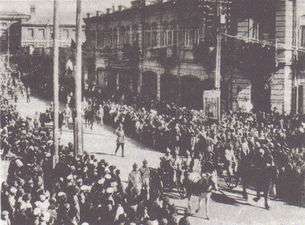Republic of Mountainous Armenia
The Republic of Mountainous Armenia (Armenian: Լեռնահայաստանի Հանրապետութիւն Leřnahayastani Hanrapetutyun), also known as simply Mountainous Armenia (Լեռնահայաստան Leřnahayastan), was an anti-Bolshevik Armenian state roughly corresponding with the territory that is now the present-day Armenian provinces of Vayots Dzor and Syunik, and some parts of the present-day Republic of Azerbaijan (Nakhchivan Autonomous Republic in the west and the de facto Republic of Artsakh in the east).[2] It was established by military commander and Armenian political thinker Garegin Nzhdeh and his allies with the support of local guerrilla forces, following the suppression of the February Uprising in April 1921. It was not recognized by any country but existed until mid-July of the same year.
Republic of Mountainous Armenia Լեռնահայաստանի Հանրապետութիւն | |||||||||||
|---|---|---|---|---|---|---|---|---|---|---|---|
| 1921–1921 | |||||||||||
.svg.png) Flag
 Coat of arms
| |||||||||||
 | |||||||||||
| Status | Unrecognized state | ||||||||||
| Capital | Goris (de facto)[1] | ||||||||||
| Common languages | Armenian (de facto) | ||||||||||
| Commander | |||||||||||
| History | |||||||||||
• Sovietization of Armenia | 2 December 1920 | ||||||||||
| 18 Feb – 2 Apr 1921 | |||||||||||
• Declared | 26 April 1921 | ||||||||||
• Disestablished | 13 July 1921 | ||||||||||
| |||||||||||
Background
Post World War I
Following World War I, the signing of the Treaty of Sèvres, and in the ensuing peace negotiations in Paris, the Allies had vowed to punish the Young Turks and reward some, if not all, of the eastern provinces of the empire to the nascent Armenian Republic.[3] However, the Allies were more concerned with concluding the peace treaties with Germany and the other European members of the Central Powers. In matters related to the Near East, the principal western powers, Great Britain, France, Italy and the United States, had conflicting interests over the spheres of influence they were to assume. While there were crippling internal disputes between the Allies, the United States was reluctant to accept a mandate over Armenia. Meanwhile, the recently formed Russian Soviet Federative Socialist Republic and Turkish National Movement had both set their sights on taking over the Caucasus, including Armenia.[4] The Bolsheviks sympathized with the Turkish Movement due to their mutual opposition to the western powers, or "Western Imperialism," as the Bolsheviks referred to it. The Soviet government formed an alliance with the Turkish nationalists and started sending them gold and weapons. This proved disastrous for the Armenians, and eventually Western Armenia fell to the invading forces.[5]
Sovietization of Armenia

Armenia gave way to communist power in late 1920. The Soviet 11th Red Army's invasion of the First Republic of Armenia started on the 29 November 1920. The actual transfer of power took place on December 2 in Yerevan, when the Armenian leadership approved an ultimatum presented to it by the Soviet plenipotentiary Boris Legran. Armenia agreed to join the Soviet sphere, while Soviet Russia agreed to protect its remaining territory from the advancing Turkish army. The Soviets also pledged to take steps to rebuild the army, to protect the Armenians and not to persecute non-communists, although the final condition of this pledge was reneged when the Dashnaks were forced out of the country. The Soviet Government proposed the annexation of the Nagorno-Karabagh and Syunik regions of Armenia to Soviet Azerbaijan. This step was strongly rejected by Garegin Nzhdeh, who declared Syunik as a self-governing region on December 25, 1920. In January 1921 Drastamat Kanayan sent a telegram to Nzhdeh, suggesting allowing the sovietisation of Syunik, through which they could gain the support of the Bolshevik government in solving the problems of the Armenian lands. Nzhdeh did not depart from Syunik and continued his struggle against the Red Army and Soviet Azerbaijan.[6]
Declaration

On 18 February 1921, the ARF led an anti-Soviet rebellion in Yerevan and seized power. The ARF controlled Yerevan and the surrounding regions for almost 42 days before being defeated by the numerically superior Red Army troops later in April 1921. The leaders of the rebellion then retreated into the Syunik region.
On 26 April 1921, the 2nd Pan-Zangezurian congress, held in Tatev monastery, announced the independence of the self-governing regions of Daralakyaz (Vayots Dzor), Zangezur, and Mountainous Artsakh, under the name of the Republic of Mountainous Armenia and later on 1 June 1921, it was renamed the Republic of Armenia.[7]
Policies
The city of Goris became the capital of the unrecognized state, and Garegin Nzhdeh was chosen as prime minister and minister of defence. Later, in July, Simon Vratsian took the office as prime minister while Nzhdeh became the governor and the general commander. Nzhdeh actively engaged in expelling the 1/4th Azeri population of Zangezur.[8]
Between April and July 1921, the Red Army conducted massive military operations in the region, attacking Syunik from the north and east. After months of fierce battles with the Red Army, the Republic of Mountainous Armenia capitulated in July 1921 following Soviet Russia's promises to keep the mountainous region as a part of Soviet Armenia. After the conflict, Garegin Nzhdeh, his soldiers, and many prominent Armenian intellectuals, including leaders of the first Independent Republic of Armenia, crossed the border into neighboring Persian city of Tabriz.
See also
- History of Nagorno-Karabakh
- List of historical unrecognized states and dependencies
References
- "Լեռնահայաստանի 85-ամյակը նշեցին միայն Սյունիքի մարզկերտում". Armtown.com. April 27, 2006. Archived from the original on July 16, 2011.
- "Republic of Mountainous Armenia (26 April 1921, capital: Goris, including: Syunik, Vayots Dzor and parts of modern-day NKR)". Archived from the original on 21 October 2014. Retrieved 26 November 2013.
- Hovannisian, Richard G. "The Allies and Armenia, 1915–18." Journal of Contemporary History. Vol. 3, No. 1 (Jan., 1968), pp. 145–168.
- Hovannisian, Richard G. (1982). The Republic of Armenia, Vol. II: From Versailles to London, 1919–1920. Berkeley: University of California Press. pp. 20–39, 316–364, 404–530. ISBN 0-520-04186-0.
- Hovannisian, Richard G. "Armenia and the Caucasus in the Genesis of the Soviet-Turkish Entente." International Journal of Middle East Studies, Vol. 4, No. 2 (April, 1973), pp. 129–147.
- "Garegin Njdeh biography". Njdeh.com. Archived from the original on May 4, 2009. Retrieved 2009-11-19.
- Mountainous Armenia
- "Garegin Nzhdeh and the KGB: Report of Interrogation of Ohannes Hakopovich Devedjian" (in Russian). August 28, 1947. Archived from the original on 2007-10-30. Retrieved July 18, 2012.
- Հայոց Գաղափարաբանության Հենասյուները from noravank.am
- Other Armenian States from freenet.am
